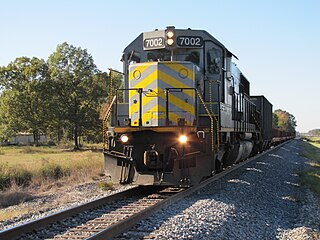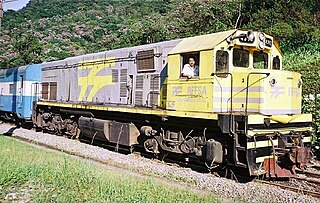Overview
With the introduction of the 645 engine for export models in 1967, the model designation numbers changed by adding 10. To meet customer demands of a six axle version of the popular G12, EMD created the GR12 which was slightly longer and taller to accommodate the six axle Type-GC trucks.
Although the orders lacked for the GR12 due to the weight and size of the locomotive, EMD revised and designed the lighter G22 series model to accommodate the Flexicoil Type-C truck and introducing the new EMD 645 series engine. With relocation of the batteries within the carbody and increasing the fuel tank capacity, the G22C series was the same length to that of its four axle counterpart, the G22. Production spanned longer than the four axle G22 version, but with smaller orders.
Several models were introduced:
- G22CW
- G22CU
- G22CU-2
- GL22C
- GL22C-2
- GL22MC
The AAR wheel arrangement system is a method of classifying locomotive wheel arrangements that was developed by the Association of American Railroads. Essentially a simplification of the European UIC classification, it is widely used in North America to describe diesel and electric locomotives. It is not used for steam locomotives,, which use the Whyte notation instead.

EMD E-units were a line of passenger train streamliner diesel locomotives built by the General Motors Electro-Motive Division (EMD) and its predecessor the Electro-Motive Corporation (EMC). Final assembly for all E-units was in La Grange, Illinois. Production ran from May 1937, to December, 1963. The name E-units refers to the model numbers given to each successive type, which all began with E. The E originally stood for eighteen hundred horsepower, the power of the earliest model, but the letter was kept for later models of higher power.

The EMD SD40-2 is a 3,000-horsepower (2,200 kW) C-C diesel-electric locomotive built by EMD from 1972 to 1989.

The EMD Dash 2 is a line of diesel-electric locomotives introduced by General Motors' Electro-Motive Division (EMD) on January 1, 1972. Designations of these models were those of the former models with "-2" added. They retained the basic specifications of the earlier models in terms of power output and most other features, but introduced a number of improvements to the locomotives' internal systems, specifically the electrical systems and the trucks of the locomotives. These were intended to improve availability, efficiency, and ease of maintenance.

The EMD SD50 is a 3,500-horsepower (2,610 kW) diesel-electric locomotive built by General Motors Electro-Motive Division. It was introduced in May 1981 as part of EMD's "50 Series"; production ceased in January 1986. The SD50 was a transitional model between EMD's Dash 2 series which was produced throughout the 1970s and the microprocessor-equipped SD60 and SD70 locomotives. A total of 431 were built.

The Evolution Series is a line of diesel locomotives built by GE Transportation Systems, initially designed to meet the U.S. EPA's Tier 2 locomotive emissions standards that took effect in 2005. The first pre-production units were built in 2003. Evolution Series locomotives are equipped with either AC or DC traction motors, depending on the customer's preference. All are powered by the GE GEVO engine.

The EMD MP15, sometimes referenced as MP15DC, is a 1,500 hp (1,119 kW) diesel–electric road switcher locomotive model produced by General Motors' Electro-Motive Division between 1974 and 1980. It was equipped with a V12 12-645E engine sporting a Roots blower. The length was either 47 ft 8 in (14.53 m) or 48 ft 8 in (14.83 m) depending on the build date.

An EMD SW1200 is a four-axle diesel switcher locomotive built by General Motors Electro-Motive Division between January 1954 and May 1966. Power is provided by an EMD 567C 12-cylinder engine, which generates 1,200 horsepower (890 kW). Additional SW1200 production was completed by General Motors Diesel in Ontario, Canada, between September 1955 and June 1964.

The EMD SD40 is an American 6-axle diesel-electric locomotive built by General Motors Electro-Motive Division between January 1966 and August 1972. 1,268 locomotives were built between 1966 and 1972. In 1972, an improved version with new electronics was developed and marketed as a new locomotive, the SD40-2.

The SD39 is a model of 6-axle diesel-electric locomotive built by General Motors Electro-Motive Division between August 1968 and May 1970. 54 were built for American railroads.

The EMD DDM45 is a meter-gauge diesel-electric locomotive built by EMD. The DD in the name means that it has eight axles in two trucks, giving it a D-D wheel arrangement, while the M stands for the meter-gauge track it was to operate on, and the 45 represents the EMD SD45 that the engine was derived from. They were built for service on the Estrada de Ferro Vitória a Minas (EFVM) in Brazil. In the early 1970s, the EFVM needed not only to expand its locomotive roster, but to use the most powerful single-engined locomotives available, and the SD45 represented the highest-rated model that EMD had to offer at the time.

Co-Co is the wheel arrangement for diesel and electric locomotives with two six-wheeled bogies with all axles powered, with a separate traction motor per axle. The equivalent UIC classification (Europe) for this arrangement is Co′Co′, or C-C for AAR.

The EMD GL8 was an export diesel-electric locomotive introduced by General Motors Electro-Motive Division (EMD) in 1960. They have been designed as light locomotives with a low axle loading. Measuring 36 feet 2 inches over the end sills, they are equipped an EMD 8-567CR engine producing 875 hp (652 kW) for traction, driving four traction motors in either A1A-A1A or B-B flexicoil trucks. The EMD GA8 is a derivative designed for very light lines with extremely sharp curves using frame mounted traction motors and freight car trucks.

The EMD GA8 was an export diesel locomotive designed by GM-EMD in the late 1950s as a simplified design for use on overseas railways with light rail and sharp curves. At the time of its introduction it was described as an extremely lightweight road locomotive capable of handling passenger or freight trains and switching. The locomotive is notable for its use of freight car trucks that are driven by cardan shafts and two traction motors attached to the underframe. Measuring 32 feet 6 inches, they are equipped with an 8-567C prime mover capable of producing 875 bhp or 800 hp traction. Late model GA8 locomotives were equipped with an 8-567E prime mover which is a 645 block fitted with 567 power assemblies. Due to the design, most servicing and maintenance could be done without removing the traction motors from the underframe or trucks of the locomotive. The units were built without multiple unit connection capability so electrical components are kept to a minimum.

The EMD G22CU is a metre gauge diesel-electric locomotive designed and built by the Electro-Motive Division of General Motors. It was manufactured by several licensees, and exported to many countries including Argentina, Australia, Brazil, Egypt, Iran, New Zealand, Nigeria, Pakistan, South Korea, Yugoslavia and Taiwan (ROC).

The EMD G22 Locomotive Series made their debut in 1967 after the rise in popularity of the export EMD G12. Designed to meet most First World, Second World and Third World country requirements, the G22 Series was equipped with a naturally aspirated EMD 645 Series engine as well as four axle Flexicoil Type-B trucks which carried a low per-axle weight. Based on customer input, the G22 Series was defined by various designations that suited the customer's railway operations.

The EMD GT22 Series were first introduced in 1972 after the rise in popularity of six axle locomotives. The GT series now carried a turbocharger that increased the horsepower depending on customer input. The GT series also utilized six axle HTC Trucks, which allowed the locomotive to haul heavier loads at slower speeds with minimal wheelslip.

The EMD GT26 Locomotive Series made their debut in 1967 after the rise in popularity of the American EMD SD40. Designed to meet most First World, Second World and Third World countries, the GT26 Series were now equipped with a turbocharged high horsepower EMD 645 Series engine as well as six axle HT-C trucks to provide better traction effort at slow speeds. Based on customer input, the GT26 Series would be defined by various designations that suit the customer's railway operations.

The EMD G18 was an export locomotive introduced by GM-EMD in the late 1960s. The standard EMD suffixes applied after the G18 designation to indicate if the customer purchased locomotives with specific traction motors to fit narrow gauge (U) or broad gauge (W) rails. An (L) indicates a locomotive built with a lightweight frame, and (6) indicates A1A-A1A trucks. The similar EMD GA18 was a G18 designed as an extremely light locomotive with low axle loading and used freight car trucks driven by a cardan shaft and underframe mounted traction motors like its predecessor, the EMD GA8. A further variation was the G18B. They are powered by an EMD 8-645E prime mover rated at 1100 bhp and 1000 hp for traction and were produced with A1A-A1A or B-B trucks.



















